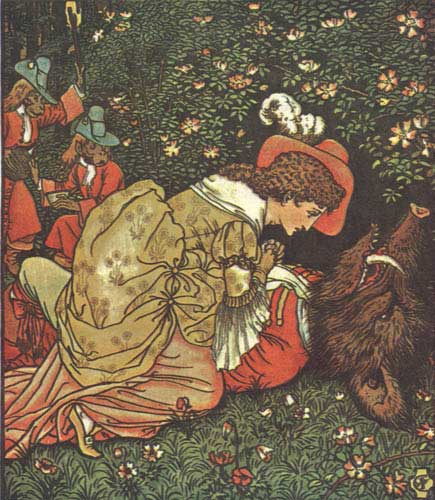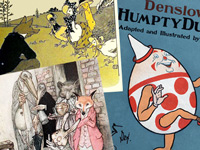Beauty and the Beast

Beauty and the Beast (French: La Belle et la Bête) is a traditional fairy tale written by French novelist Gabrielle-Suzanne Barbot de Villeneuve and published in 1740 in La Jeune Américaine et les contes marins. Her lengthy version was abridged, rewritten, and published by Jeanne-Marie Leprince de Beaumont in 1756 in Magasin des enfants to produce the version most commonly retold.
Variants of the tale are known across Europe. In France, for example, Zémire et Azor is an operatic version of the story, written by Marmontel and composed by Grétry in 1771, which had enormous success well into the 19th century; it is based on the second version of the tale. Amour pour amour, by Nivelle de la Chaussée, is a 1742 play based on Gabrielle-Suzanne Barbot de Villeneuve's version. According to researchers at universities in Durham and Lisbon, the story originated around 4,000 years ago.
Plot
A wealthy, widowed merchant lives in a mansion with his six children, three sons and three daughters. All his daughters are very beautiful, but the youngest, Beauty, is the most lovely, as well as kind, well-read and pure of heart; while the two elder sisters, in contrast, are wicked, selfish, vain and spoiled, and secretly taunt and treat Beauty more like a servant than a sister. The merchant eventually loses all of his wealth in a tempest at sea. He and his children are consequently forced to live in a small farmhouse and work for their living.
After some years of this, the merchant hears that one of the trade ships he had sent off has arrived back in port, having escaped the destruction of its compatriots. He returns to the city to discover whether it contains anything valuable. Before leaving, he asks his children if they wish for him to bring any gifts back for them. The sons ask for weaponry and horses to hunt with, whereas his oldest daughters ask for clothing, jewels and the finest dresses possible, thinking his wealth has returned. Beauty is satisfied with the promise of a rose, as none grow in their part of the country. The merchant, to his dismay, finds that his ship's cargo has been seized to pay his debts, leaving him without money to buy his children their presents.
During his return, the merchant becomes lost in a forest during a storm. Seeking shelter, he enters a dazzling palace. A hidden figure opens the giant doors and silently invites him in. The merchant finds tables inside laden with food and drink, which seem to have been left for him by the palace's invisible owner. The merchant accepts this gift and spends the night there. The next morning as the merchant is about to leave, he sees a rose garden and recalls that Beauty had desired a rose. Upon picking the loveliest rose he can find, the merchant is confronted by a hideous "Beast" which tells him that for taking his most precious possession after accepting his hospitality, the merchant must die. The merchant begs to be set free, arguing that he had only picked the rose as a gift for his youngest daughter. The Beast agrees to let him give the rose to Beauty, but only if the merchant or one of his daughters will return.
The merchant is upset, but accepts this condition. The Beast sends him on his way, with wealth, jewels and fine clothes for his sons and daughters, and stresses that Beauty must never know about his deal. The merchant, upon arriving home, tries to hide the secret from Beauty, but she pries it from him. Her brothers say they will go to the castle and fight the Beast, but the merchant dissuades them, saying they will stand no chance against the monster. Beauty accepts responsibility for her actions and willingly goes to the Beast's castle. The Beast receives her graciously and informs her that she is now mistress of the castle, and he is her servant. He gives her lavish clothing and food and carries on lengthy conversations with her. Every night, the Beast asks Beauty to go to bed with him, only to be refused each time. After each refusal, Beauty dreams of a handsome prince who pleads with her to answer why she keeps refusing him, to which she replies that she cannot marry the Beast because she loves him only as a friend. Beauty does not make the connection between the handsome prince and the Beast and becomes convinced that the Beast is holding the prince captive somewhere in the castle. She searches and discovers multiple enchanted rooms, but never the prince from her dreams.
For several months, Beauty lives a life of luxury at the Beast's palace, having every whim catered to by servants, with no end of riches to amuse her and an endless supply of exquisite finery to wear. Eventually, she becomes homesick and begs the Beast to allow her to go see her family. He allows it on the condition that she returns exactly a week later. Beauty agrees to this and sets off for home with an enchanted mirror and ring. The mirror allows her to see what is going on back at the Beast's castle, and the ring allows her to return to the castle in an instant when turned three times around her finger. Her older sisters are surprised to find her well fed and dressed in finery. They are envious when they hear of her happy life at the castle, and, hearing that she must return to the Beast on a certain day, beg her to stay another day, even putting onion in their eyes to make it appear as though they are weeping. They hope that the Beast will be angry with Beauty for breaking her promise and eat her alive. Beauty's heart is moved by her sisters' false show of love, and she agrees to stay.
Beauty begins to feel guilty about breaking her promise to the Beast and uses the mirror to see him back at the castle. She is horrified to discover that the Beast is lying half-dead from heartbreak near the rose bushes her father had stolen from and she immediately uses the ring to return to the Beast.
Beauty weeps over the Beast, saying that she loves him. When her tears strike him, the Beast is transformed into the handsome prince from Beauty's dreams. The Prince informs her that long ago a fairy turned him into a hideous beast, after he refused to let her in from the rain, and that only by finding true love, despite his ugliness, could the curse be broken. He and Beauty are married and they live happily ever after together.
LITERATURE FAIRY TALES

Illustration for Beauty and the Beast by Walter Crane

Illustration for Beauty and the Beast by Walter Crane
( Click image to enlarge)
A fairy tale is a type of short story that typically features folkloric fantasy characters, such as dwarves, elves, fairies, giants, gnomes, goblins, mermaids, trolls, or witches, and usually magic or enchantments. Fairy tales may be distinguished from other folk narratives such as legends (which generally involve belief in the veracity of the events described) and explicitly moral tales, including beast fables. The term is mainly used for stories with origins in European tradition and, at least in recent centuries, mostly relates to children's literature.
Read More » List of Fairy tales »
RESOURCES
This article uses material from the Wikipedia articles "List of fairy tales", "Fairy tale" and "Beauty and the Beast", which is released under the Creative Commons Attribution-Share-Alike License 3.0.
© Stories Preschool. All Rights Reserved.





